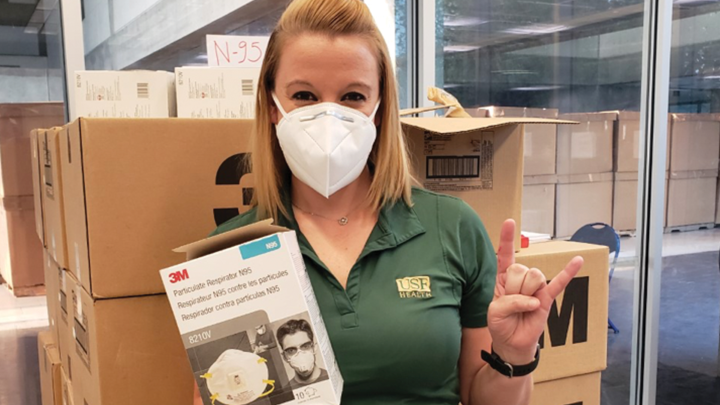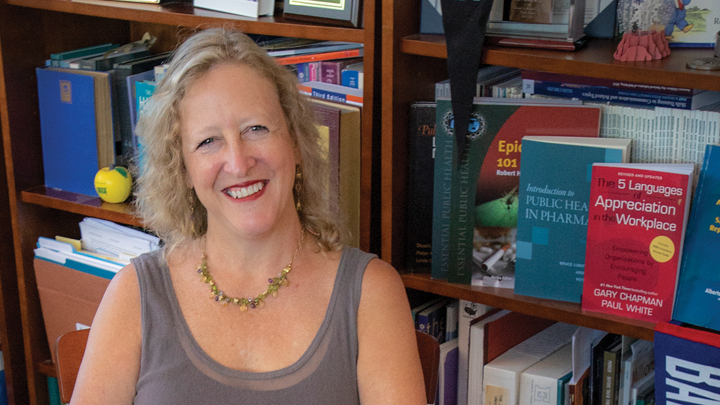Current Features
Public Health Faculty Work Across the State to Monitor, Fight Spread of Disease
– USF RESPONDS: COVID-19 –
By Donna Campisano

IN MID-MARCH, College of Public Health Dean Donna Peterson sent an email to the college’s faculty with the subject line “an unprecedented opportunity.”
The email was sent just as USF and the country were bracing for the coming onslaught of COVID-19 cases. It asked faculty to work with the Florida Department of Health and emergency operations management in various counties and capacities across the state to monitor and fight the spread of the disease. This, in addition to teaching their online courses and continuing with their research.
All in all, roughly a dozen faculty members responded to the call, doing everything from contact tracing to compiling medical profiles on those who had died from the virus to procuring personal protective equipment (PPE) for hospitals and health-care centers.
What were their experiences like? What will they remember weeks, months and years from now? Five of the faculty members shared their stories.
On difficulties getting people to adhere to guidelines
Marie Bourgeois, ’91, MPH ’06 and PHD ’10, assistant research professor, was deployed to hard-hit Miami-Dade County where she worked to put together medical history profiles on those who died from COVID-19, many of whom, she said, had COPD, diabetes and/or chronic kidney disease.
“We were sending people into nursing homes and assisted living facilities where patients had been identified as having the virus, instructing the staff on vulnerabilities they might have. In one home a nurse told us that (COVID) patients who were smokers would still insist on sneaking outside for cigarettes. They had the masks with them because the facility required them all to follow safety protocols, but they would scrunch them down under their chins to smoke. She was afraid they would catch on fire. But there is such a thing as free will. You’re not necessarily going to convince an 85-year-old who has survived the Great Depression and World War II that you have a significant amount of control over him/her. She couldn’t get them to see the risk of a virus that could kill them when they had already lived through such tumultuous times.”
On preparedness (or lack of it)
Elizabeth Dunn, ’07, ’08 and MPH ’11, instructor, current doctoral candidate and recipient of the college’s 2020 Excellence in Teaching Award, is working with the Hillsborough County Office of Emergency Management securing PPE for health care professionals. She’s also placed 16 students in positions around Hillsborough County, assisting with COVID-19 support, logistics and coordination efforts.
“The lack of PPE available has been most unexpected – and a surprise to me personally. I believe planning prior to this large-scale event – on a national level – regarding supply chain disruptions should have been anticipated and taken into account. It would have helped us understand what sort of medical equipment, supplies or medications would be in short supply due to an interruption (in manufacturing or distribution). That being said, however, this whole experience has shown how progressive our county and the city of Tampa are in taking a whole-community approach to tackling these challenges regarding COVID-19 as they arise. Our emergency management officials are responding and coordinating along with health department experts and USF Health. Instead of each of us working in silos, we’re working together. One good example: We’re launching a research project to look at COVID-19 considerations as we prepare evacuation shelters for the upcoming hurricane season.”
On fear of the virus
Matawal Makut, MPH ’12 and MBA ’15, faculty instructor and medical doctor trained in Nigeria, was deployed to rural Madison County where he traced contacts of COVID-19 patients.
“Honestly, I am really excited at this opportunity to experience public health in action. We constantly teach our students about epidemiological concepts, but being able to personally apply such concepts in the middle of a pandemic has been a great experience so far. Yes, fear of the virus is real, and I have told myself the only way to stay safe is to observe the basic precautions of social distancing, washing my hands regularly and using hand sanitizer. I also wear an N95 mask since I am with the health department and they sometimes swab patients. We’ve signed up to do this job and it will be great to contribute my quota and flatten the curve while also staying safe.”
On community
Stephanie Marhefka, professor and assistant dean for research, worked remotely for Monroe County, tracing contacts and entering/studying data.
“When I began calling contacts of confirmed cases for their daily monitoring, I was surprised at the response. I was calling from my cell phone – a 917 area code – when the contacts were likely anticipating a call from a number starting 305. I didn’t expect many contacts to answer – but they did! My next surprise was that they appreciated the phone call. They thanked me for following up. It seemed that in this time of fear and so much ambiguity, the calls brought them comfort. They were grateful to know that someone was looking out for them. Previously, when I was entering data from forms staff had completed during contact monitoring, I was thinking about ways to automate the monitoring process. Wouldn’t it be more efficient if we use a texting system to complete the monitoring? But now, I realize that the monitoring process may be important for supporting people through a very difficult time. What must it feel like to know you were exposed to someone with COVID-19 – especially for someone who is elderly and/or has underlying health conditions that put them at high risk for poor outcomes? Maybe that call helps some people to feel a little less alone at a time when they fear death is about to come knocking on their door.”
On professional responsibility
Deidre Orriola, MPH ’06, adjunct faculty member, also deployed to Madison County and performed contact tracing, including going to individual homes.
“Things are up and down. We had our first death today in the county from COVID-19. But we have also cleared many people from self-isolation and monitoring. I cleared five today. I made my last call and sent them a letter that they were being released from monitoring, although they are advised that Florida is still under a stay-at-home order. That’s rewarding and feels good. At the end of the day I fist-pump in the air and say, ‘Yay! We got five released today!’ I would do this again in a heartbeat. I feel a responsibility to use the skills I have to educate and prevent (disease) and help people get through this. We’re gradually seeing that curve flatten and I am proud to show my children that this is what I’m doing to help.”
WHAT HAVE WE LEARNED? WHAT NEEDS TO CHANGE?
Donna Petersen, dean of the College of Public Health, looks back – and ahead

SIX MONTHS AGO, IF YOU ASKED someone what public health was, you probably would’ve heard something vague. “It has something to do with health care, right? And keeping people healthy?”
Yes. And yes again.
But it’s that and a whole lot more. Especially when viewed through the lens of a pandemic.
“When we’re at our best, we’re preventing disease and threats to health,” says Donna Petersen, dean of USF’s College of Public Health and senior associate vice president of USF Health. “And when we do that, people forget we’re there. We hope this pandemic has helped people realize that public health matters, and we need to make investments in it.”
What else has COVID-19 taught us? Petersen offers hindsight and highlights:
Do you think we were prepared for this pandemic – for its scope and virulence?
Public health experts have been preparing for a pandemic for years. We’ve been arguing that we need more trained staff, more materials and supplies, more surge capacity in the health-care system. All the things people were saying we didn’t have enough of, and they were right. It’s not that COVID-19 caught us unaware. We’ve been training for this. But we weren’t sufficiently prepared. It’s hard to get people to invest in things that you hope won’t ever be needed.
Stand 6 feet apart. Wash your hands for 20 seconds. These measures have been drilled into us. And still the virus spreads. Short of a vaccine, what else is in our toolkit to combat COVID-19?
We have good public health messages and good data collection, and we’ve conveyed the information regularly, honestly and transparently. But it’s not always enough. Some people will heed the advice, some will ignore it and still others will think it doesn’t apply to them. So the next step is engineering solutions --for example, those Plexiglas shields you see at the supermarket that protect you and the cashier from transmission of the virus. But that’s just one step. We also have policy directives to try and force people to change behavior, things like the safer-at-home order. We don’t like to do this. We hope we can just persuade people to do the right thing. But sometimes you have to force them.
In a way, you and your public health colleagues are soldiers and this is your war. How do you feel about going to battle?
Ideally you want to anticipate and prevent these things. But when that doesn’t happen, for whatever reason, you have to be able to respond. I’m incredibly proud of our alumni, students, faculty and staff all over the world working on the front lines. And if they’re not on the front lines, they’re trying to keep other public health efforts going in the wake of COVID-19, because [things like housing and food insecurity] don’t stop because there’s a pandemic. When the Florida Department of Health asked our faculty, students and staff to step up, they did. One hundred-fifty have been deployed, many doing contact tracing. And that’s a valuable part of the toolkit. This is what we train people to do and it’s marvelous to see them in action. It’s exciting on one level, but we wish we weren’t doing it. We would much prefer to capture this early and prevent the spread.
What can we do better next time?
Making sure people have easy access to health care is tops on the list. I also hope we recognize the power of paid sick leave. When people have symptoms of any kind of illness, they need to not go to work and still get paid, and they need to be able to get to a health-care provider. We still don’t know how many people have not sought care for COVID-19. We’re relying on people who feel sick or who may have been exposed to bring themselves to the attention of a health-care worker. And if they don’t have health-care coverage, or they’re afraid to take a day off, then we don’t get a good sense of how many are carrying and spreading the virus in the community. Those are compelling issues we have to continue to debate and find a solution for.
So, when all this is said and done, do you think people will know what public health is?
I hope people will gain an appreciation and respect for public health and what public health professionals do. I also hope they’ll be more supportive when we ask for investments in the public health infrastructure, so we can effectively respond to challenges in the future. When you open a newspaper today, it is all about COVID-19. But we will come back to a day when we talk about whether it’s safe to eat lettuce. And when we do, I hope people realize that, ‘Hey, those are the same people who told me to stay at home and wash my hands. Maybe I should listen to them about the lettuce!’
- DONNA CAMPISANO | College of Public Health